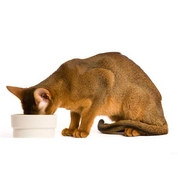The cat is a carnivore
Unlike man who is an omnivore, the cat is a strict carnivore with a body perfectly adapted to this type of diet. Feeding cats with a Health Nutrition food suited to their age, their size, their lifestyle, specific sensitivities and even to their breed means supporting their health and wellbeing.
With jaws designed to cut, not to chew, their 30 sharp-cutting teeth, their saliva which contains no digestive enzymes, a stomach designed to digest quickly swallowed “preys,” the cat distinguishes itself by a very specific dietary behaviour. Indeed, this nibbler can indulge 12 to 18 small meals a day, for an overall length of less than 30 minutes spread over a 24-hour period, ingesting only a few grams each time. This style of feeding means that food actually reaches their stomach in large chunks.
Therefore, meeting the cat’s nutritional requirements implies a specific diet that takes into account not only their lifestyle or age, but also their health, neuter status, specific breed features and particular sensitivities, so as to support them well throughout their life.
Outdoor cat or indoor cat?
A cat that does not go out spends little energy. The normal intake of a 3.5-kg inactive cat, with no excess weight, is put at about 50g of kibbles a day, of a dry food containing around 350 kcal/100g of diet.
For some cats with a tendency to eat to keep themselves busy, it is essential to set the quantity to be served every day. At the same time, choosing a Health Nutrition food with a moderate energy density is crucial to help reduce the risk of excess weight gain, all the more so as an indoor life often goes together with neutering. We know that due to a reduction in hormones after neutering a cat’s appetite is stimulated, and their desire to exercise declines. Indeed, their weight may increase by as much as 30% within the months following neutering.
A cat that goes out regularly has higher energy requirements, approximately 70 kcal/kg body weight per day. This need increases according to the time spent outdoors, the extent of the territory available to them, and the range of temperature variations throughout the year. However, a cat’s diet is not set once for ever: many so-called “outdoors” cats become true “indoors” cats when winter comes – and diet should be adjusted accordingly!
An adult indoors cat spends about 30% of their waking time licking their coat. The hairs ingested are then eliminated via the intestine, but this grooming activity represents a major risk of hairball formation in the digestive tract. The natural elimination of these hairs may be helped by stimulating intestinal transit with a Health Nutrition food enriched with non-fermentable fibre.
According to breed
Even though pedigree cats are more often kept indoors, their requirements are as different as they and their appearances are. Between a 10kg Maine Coon with medium-length hair and strong jaws, an active, all-muscle short-haired Siamese and a long-haired brachycephalic Persian, the nutritional requirements do not lead to the same Health Nutrition answer.
Thus, for instance, the Siamese will require a high protein diet and l-carnitine to help maintain its long muscular shape, while the Persian must be given food whose shape is suited to its jaws and nutrients contributing to the good health of its hair.
According to age
The cat’s average lifespan is 14 years, but cats over 20 years of age are no longer something rare. Better care and a tailored Health Nutrition diet may contribute to the quality and health of the cat’s life expectancy.
Ageing in cats comes with a decline of the immune defence system, a decline in ability to fully absorb all dietary nutrients and a loss of appetite. Chewing also becomes more difficult. The body may then be supported by a Health Nutrition answer suited to the ageing cat. Among other features, it will have a softer texture, an enriched vitamin content and reinforced palatability.
Particular sensitivities
An estimated 70% of cats over 3 years of age develop dental problems. These issues often go unnoticed while the pain they cause may have serious consequences upon the cat’s behaviour and general health. The correct diet can help to maintain good dental health.
Indeed, using kibbles whose size and texture encourage the cat to crunch makes it possible to perform mechanical brushing of dental surfaces and to slow down plaque development.
